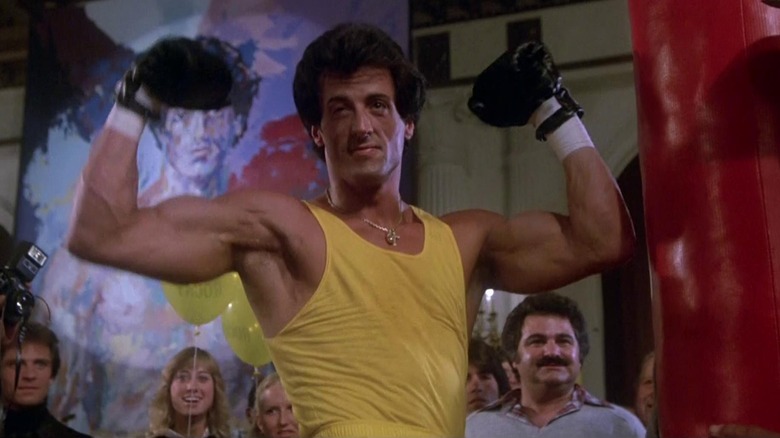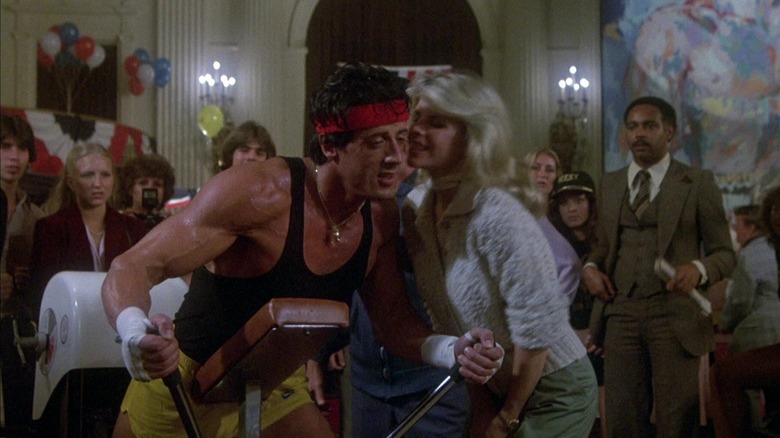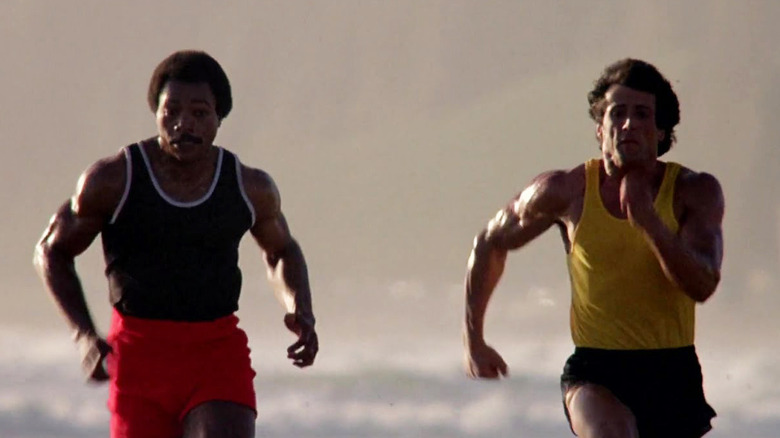Rocky III Has The Greatest Training Montage Of All Time
Okay, so you're about to read a thousand-odd words about why "Rocky III" features the greatest training montage of all time. But before you continue, just stop right now and listen to this song.
Welcome back! I hope you enjoyed listening to one of the greatest, most iconic, most inspirational rock tracks ever recorded. Look, the entirety of "Rocky III" could be a single, long, and unbroken take of Sylvester Stallone pumping iron in a dimly lit gym, and as long as Survivor's "Eye of the Tiger" was playing underneath, it would still be one of the best movies of all time.
Yes, it's true that "Eye of the Tiger," while used multiple times during the movie, does not feature during the training montage. But oh, the training sequence in "Rocky III" is gloriously, wondrously, just as good as that badass song. So come along as we unveil the monument to the human body (and spirit) that is the "Rocky III" training montage, and hurry up because "There is no tomorrow!"
Balboa succumbs to true weakness
As with any great montage, context is everything. "Rocky III" actually contains two training montages, and the first of the two is quite possibly Robert "Rocky" Balboa (yes, that's his full name) at his lowest point. Granted, Rocky had been through trials before and would go through many more hard times after, but those struggles tended to revolve around his body and will; "Rocky III" sees Balboa start to lose his soul.
Although "Rocky II" saw the boxer flirt with the pitfalls of fame by selling out, it's during the first half of "Rocky III" where Stallone (who wrote and directed the film) depicts the character succumbing fully to his weakness, buying into the vapid adoration of fans and basking in his own glory. Where the prior "Rocky" films saw the underdog Italian Stallion literally rise from the streets of Philly to ascend the steps of victory during those training montages, the so-called training session that Rock arranges during this first montage in "Rocky III" is like some vision of disco Hell. It's tacky, gaudy, and glitzy, with neon signs in one corner, a singing act (hello, Frank Stallone) in the other, and fans and merchandise all around.
The frail and sickly Mickey (Burgess Meredith) is the only one apart from Adrian Balboa (Talia Shire) to realize the danger this environment represents, and Stallone makes sure to cut from Mickey's worried expressions to footage of Clubber Lang (Mr. T) training alone in a sparse gym, the murderous hunger in his eyes in stark contrast to Rocky's lackadaisical sparring. The montage is so pointed that it's almost a formality to watch Clubber beat the snot out of Rocky shortly after — he'd already lost before he ever stepped into that ring. While watching "Rocky III," it's clear that Stallone was after something raw.
The ballad of Rocky and Apollo
One of the joys within "Rocky III" is the evolution of the relationship between Rocky and Apollo Creed (Carl Weathers). Boisterous opponents during the first two "Rocky" movies, Creed is a humbler and more enlightened man in "Rocky III," having lost the title of World Heavyweight Champion to Balboa in the prior film. When Rocky loses that title to Clubber after that first disastrous bout (not to mention losing his mentor and trainer Mickey in the process), Creed extends a helping hand to his one-time rival, offering to train him for a rematch with Clubber at his old gym in the streets of Los Angeles.
Enemies-to-friends is always an emotionally powerful arc for characters, especially in a serialized story. Heck, the "Fast and Furious" movies keep doing it over and over again! "Rocky III" just might be one of the most heartwarming and inspiring examples of the trope — after all, Rocky and Creed were merely opponents, not bitter foes, and it's a joy to watch the two review their old fights with each other as Creed gives Rocky some pointers. Their relationship grows even deeper as Creed realizes that he's not just retraining Rocky into a new fighter, but helping a friend to emerge from the funk of depression, grief, and loss.
Bodies in motion and the power of bromance
Finally, after an hour of Rocky Balboa falling from grace, he shares a tender moment with Adrian. Once his wife reminds him of the good man and great fighter beneath his fear and self-pity, the training montage hits, and it's a doozy. The strains of Bill Conti's immortal "Gotta Fly Now (Theme From Rocky)" blast onto the soundtrack, and Rocky and Apollo run down the L.A. beach in tandem.
Throughout the entire montage, Apollo is there, at Rocky's side, pushing him forward and expanding his limits. As we see the duo spar, race on the beach, swim, and jump rope, it becomes clear that this is a new and different Rocky — he's got a speed and agility that wasn't there before. He's a man who's been changed and enriched by his friends and family, a brand new fighter who can give a young upstart like Clubber a run for his money. To use the film's terms: he's regained the eye of the tiger.
He's also gained the love of a friend for life, as evidenced by the consistent pairing of himself and Apollo. Stallone builds the montage around footage of Apollo and Rocky racing on the beach in slow motion, the better to see every ripple of every strained muscle against the men's brightly colored outfits. The montage ends as Conti's music crescendos, Rocky wins the race and the friends embrace, smiling and shouting in victory as they splash within the Pacific Ocean's waves.
The montage is a three-minute ode to the beauty of the human male body, a showcase of strength, coordination, and willpower. It's also a paean to male bonding, soaring beyond mere homoeroticism to a glorious pinnacle of pure, unadulterated love. Its character and spectacle are in perfect harmony, and thus it is the greatest training montage of all time. Cue the song!



